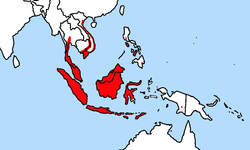Behavior
The ricefield rat lives in large groups which consist of a dominant male and high ranking female. When attacked or disturbed they will make squeals and whistles sound. Rattus argentiventer's main diet includes termites, insects, grasshopper, snails, seeds, nuts, rice, vegetables, and fruits. They feed at night and actively moving at dusk and dawn. During daytime, they can be seen among vegetation, weeds or maturing field. It undergoes 3 week gestation giving birth about 5 to 10 young per litter.
Distribution
The ricefield rat can be found throughout Southeast Asia consists of Indochina region, Thailand, Peninsular Malaysia, Indonesia, Philippine, and New Guinea as major rodent pest in rice field area.
Although not a part of staple human diet in Cambodia, a growing market has developed there with most exports going to Vietnam. [2] Rat-catching season reaches its height after the rice harvest in June and July when rats have little to eat. That lack of food coincides with seasonal rains that force the rodents onto higher ground, where traps are set up to catch them.
This page is based on this
Wikipedia article Text is available under the
CC BY-SA 4.0 license; additional terms may apply.
Images, videos and audio are available under their respective licenses.


